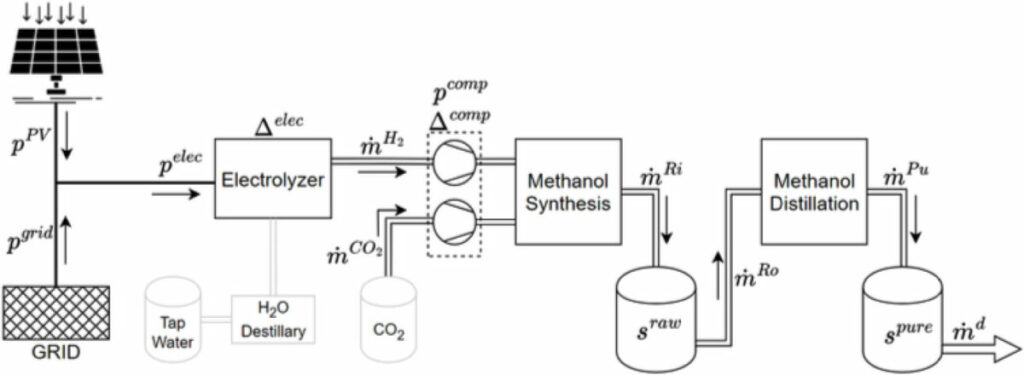New research from Denmark shows PV-to-methanol facilities may achieve 30% lower levelized cost of methanol through engagement in reserve markets. The researchers examined the ability of a PV-to-methanol plant to contribute to the grid in frequency containment reserves (FCR), automatic frequency restoration reserves (aFRR), and manual frequency restoration reserves (mFRR).
May 30, 2024 Lior Kahana
A group of researchers led by scientists from the Technical University of Denmark (DTU) has investigated how PV-to-methanol plants may participate in reserve markets to minimize the levelized cost of methanol and has found these facilities could achieve potential economic benefits.
The academics examined, in particular, the ability of an actual PV-to-methanol plant to contribute to the grid in frequency containment reserves (FCR), automatic frequency restoration reserves (aFRR), and manual frequency restoration reserves (mFRR).
“To optimize the cost-effectiveness of power-to-X (PtX)-based fuel production, a proposal suggests leveraging PtX plants’ inherent flexibility to provide frequency reserves to the electrical grid,” they explained. “Analyzing the hybrid renewable energy system (HRES) technology and current reserve markets reveals that the HRES qualifies for frequency reserve provision certification, encompassing FCR, aFRR, and mFRR, by the transmission system operator.”
The PV-to-methanol plant that was analyzed can produce some 32,000 tons of e-methanol a year. It is powered by the grid and a 300 MW PV plant connected to proton exchange membrane electrolyzers (PEM) with a capacity of 52.5 MW. The PEM unit has a minimum load of 5%.
“While existing studies predominantly simulate short-term scenarios, this research extends its focus to a full year, shedding light on the dynamics of renewable energy integration and market management over an extended period,” stated the research team. “The comparison involves two scenarios: participation solely in the day-ahead (DA) market and engaging in both the DA and reserve (RE) markets for the years 2020 and 2021.”
The plant is located near the German border, in Kassø, Southern Jutland. Per the mathematical model, solar PV power accounts for 66% of the total energy utilized by the system annually. However, during the summer months, the PV capacity exceeds that of the power-to-X facility, resulting in surplus PV production, which can then be used for export to the grid and reserve market participation.
“For both years, the aFRR market proves to be the primary source of additional revenue, while the mFRR and FCR participation contributes to a lesser extent,” the team stated. “In 2020, reserve market revenues total €4.82 million ($5.23 million), with FCR accounting for 16%, aFRR 79%, and mFRR 5%.”
For the DA market alone, the model found a levelized cost of methanol (LCoM) of €1,508/t in 2021 and €1,276/t in 2020. For both DA and RE markets, the model shows an LCoM of €1,059/t for 2021 and €1,117/t for 2020. According to the researchers, these results account for a reduction of LCoM of 30% for 2021 and 12% for 2020.
“The model efficiently allocates electrolyzer capacity to maximize market returns, with resulting LCoM values closely matching international renewable energy agency (IRENA) estimates,” concluded the academics. “This underscores the economic benefits of HRES participation in reserve markets, indicating the potential for enhanced renewable energy system sustainability through market involvement.”
Their findings were presented in “Cost minimization of a hybrid PV-to-methanol plant through participation in reserve markets: A Danish case study,” published in the International Journal of Hydrogen Energy. Academics from Denmark’s DTU and China’s University of Chinese Academy of Sciences conducted the research.
This content is protected by copyright and may not be reused. If you want to cooperate with us and would like to reuse some of our content, please contact: editors@pv-magazine.com.
>>> Read full article>>>
Copyright for syndicated content belongs to the linked Source : PV-Magazine – https://www.pv-magazine.com/2024/05/30/pv-to-methanol-plants-may-maximize-returns-in-reserve-markets/
